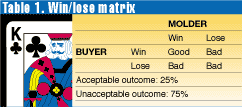Pricing games: Building a winning hand
May 1, 2002
|
In the January 2002 issue of IMM (pp. 29-30) there was an excellent article on reverse auctions. This is one of several games buyers are playing with molders to squeeze down pricing.
The essence of this game is the "there are a dozen molders like you" scenario. Everyone is chatting up the win-win thing. But look at the matrix (Table 1): If you only look at winning and losing, your odds of success are 25 percent, which is not very good.
Remember, winning is perceived. In molding this means you ship parts and get paid. The buyer gets parts and makes salable product. While your goals are different, the perception of winning is mutual for everyone in the transaction. Losing, however, is measurable: You lose profits or the buyer doesn't get acceptable parts. Few people remember good outcomes but they always remember losing.
Now let's expand the matrix (Table 2). What if you had two more options? You could neither win nor lose but simply maintain the status quo, or you could not play and neither win nor lose. The odds of a successful outcome double. So much for game theory.
The problem with most molders is that they
|
are afraid of their customers. As a consultant, I've listened to the whining about mandatory price reductions, auctions, and everything else done to a molder. Even with the whining, the molder usually caves in, thinking that keeping the business is better than losing it. It's kind of like the schoolyard bully stealing your sandwich and then telling you what he wants for tomorrow's lunch. Didn't you stop playing that game in grade school?
Think for a minute: Is it better to have a job that loses money or machine capacity you can fill with a job that makes money? Enough said.
Assessing Your Gamesmanship
Most buyer games are really comprised of bluffing. Most molders fold because of the bluff. However, it is easy to call the bluff and either stay in the game or get out before you lose. So how do we do it? First dispel the myth. If there were a dozen other molders like you out there, your customer probably would have picked someone else! Second, somewhere you have a competitive advantage that made you the vendor for the job. You need to communicate to the buyer why it needs you (and not the reverse). Here are a few metrics you should consider first when assessing your strengths:
Technology. Not all molders need new machines, robots, vision systems, automatic packaging systems, and so forth. These are nice things to have, but they are also expensive. If you specialize in ultrahigh-volume runs with precision in an industry sector like medical, such equipment is the ante for playing the game. But, if you are making consumer products such as washing machine tubs, it's the size of your equipment that is the key determining factor. Your technology must fit your product line. Nobody is a custom molder. Everybody specializes. You only need to understand what you do well and sell that concept. To that end, your client base should match your expertise, not the other way around.
Quality. I don't know of a buyer who doesn't want high Cps and CpKs. They want to order 10,000 parts and have them all defect free. This only happens if the part design and the quality expectations are reasonable. Only in the highly regulated industry sectors are "parts to print" the determining factor. Parts that work are really all anyone wants. This is a tough battle to win, but it is a reality that needs to be explained and reinforced to your client.
Delivery. In all the measures of success of a customer-supplier relationship, delivery is the primary metric. It is an interesting exercise to point out to your buyer his need to pay for expedited freight and overtime costs when he absolutely has to have it. He'll also accept parts slightly not to print or even stall an engineering change so long as you keep shipping. His esteem for you goes up when he pushes back a delivery with you only doing a little complaining. This esteem really goes up when he is caught short, you whine about schedule bumping, and then ask for a premium (for your overtime costs) to run his rush job when you are actually shipping out of your secret just-in-time warehouse.
Price. In the buyer's perfect world, you'd buy resin for $3.00/lb and sell parts for $3.01/lb. This myth is both silly and foolish. While scrap reduction is the highest source of improved profit to the molder, any time a buyer pays for anything additional to keep his production lines supplied he has just admitted price is not a determining factor.
Improving Your Odds
Now let's improve your odds of not being in the losing column. We'll use reverse auctions as an example. Sometimes you'll get a package with a whole stack of parts and prints with a letter that asks you to quote everything and telling you the job will be placed as a bundle. Bundling is a common technique now and is a thinly veiled way to trim the vendor list.
You have two options:
Call the buyer and inform him that you want a purchase order for 1.5 hours per part multiplied by your engineering hourly rate ($150/hr). Bundling and auctions almost always mean you aren't bidding against two or three companies but against 10 or 20. If you are going to waste the time bidding, get paid for it. If the buyer won't pay, don't bid. You probably won't get the job anyway.
Sometimes (as a surprise) you'll see your own parts in the mix to bid. Here you can play hardball or softball.
Hardball. If you are already on the low end of your profit expectation, the buyer is really telling you he wants to pull the job. Remember, no matter what he says, he isn't offering you more business. Quietly call him and mention you don't take kindly to threats. If he wants to pull the job, you'll close all existing orders, stop molding, and await his decision on who the new molder will be.
Softball. This is a modified version of hardball. Call the buyer before telling him/her you'll stop producing and ask if anyone else who is bidding has a performance record like yours in delivery and quality. If he says he's just benchmarking you to keep you honest, get indignant. You don't need a customer like this! (It's like asking your spouse if he/she was faithful to you today.) If he says everything you are doing is OK, tell him you will decline to bid and wish him well if he finds someone else who can keep his production lines up as well as you do. Try to communicate that consistent supply is better than low price. Let the buyer make the choice and then hope he can swallow (or choke on) it.
Choosing Not to Play
Threatening is really what auctions, vendor consolidation programs, and price reduction programs are all about. When molders are threatened they tend to panic. This "new" way of doing business is completely different from what they expected. While an effective purchasing technique, the only response to it is to threaten back. Never threaten directly; threaten implicitly. Point out some natural consequences to the buyer's actions. If he has threatened one job and you have others, bundle back: If you are going to be nailed on one project he can have all his jobs sent back when you lose one.
There is a word of caution here: While business
|
should never be based on threats and punishments, this is reality. Therefore, never bluff. If you make a threat, carry it through. If you can't, don't bluff in the first place.
Playing hardball or softball is an effective tool. Keep in the front of any discussions that the best sales tool isn't price, it's delivery performance—parts of sufficient quality, delivered consistently on time. The most profitable molders are the ones who get rid of feisty buyers/clients, turn down jobs they are not suited for, and don't take bundled jobs, but have a consistent reputation for quality and delivery. The guys who are currently going out of business play these price reduction games with their clients.
Greed is another problem. Too many molders look at a new job and only see the dollar sales. If the quote asks for pricing from lots of 5000 to 1 million pieces, two things will happen. First, the buyer will ask for the 1 million part price but order in lots of 5000. Second, the forecast is usually a pipe dream. A quote with this much of a spread is asking you to commit to capacity but not to sales. With times as they are you cannot reserve capacity for orders that don't materialize.
If you find out one of your clients is doing auctions, get rid of that customer. Just because you haven't been asked to bid doesn't mean your parts aren't being cross-quoted. If you mold the parts, you know all the problems. The other guys don't. If they pull the job, just ship the mold. Don't offer any help. If asked, sell your time for $1000/hr with a prepaid PO when the other molder is in trouble.
Remember how long it took to get the job qualified? Have you used a special hot tip, modified the venting, or put runner dams in the mold to balance the fill? This took time. Your buyer doesn't have time. If he threatens to pull the job if you don't drop the price, threaten back. Tell him you can have the job on his shipping dock tomorrow if he has the check. He'll have to scramble to find another qualified source, especially if you remove your special vents and tips and ship the mold as originally manufactured.
If you feel a buyer is trampling you, don't complain to him or go home and sniffle. Go up the food chain. Upper management never wants to hear about their supply lines being threatened. They'd rather pay a little more for the insurance of a continued supply of parts than the cost of lost production because of the lack of components. Besides, finding a new buyer is usually easier than finding a new supplier, and it's cheaper, too. Get a reputation for not being kicked around but also for playing fair, and your sales and profits will actually improve. Good luck.
Consultant Bill Tobin of WJT Assoc. is a regular contributor to IMM.
Contact information |
You May Also Like




